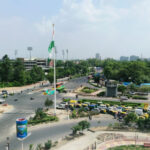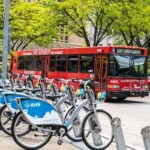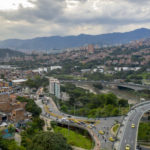Posts tagged with 'pedestrian infrastructure'
Mexico became the first nation to declare access to safe mobility a human right in 2020 and two years later passed the General Law of Mobility and Road Safety to protect people, reduce collisions and promote sustainable modes of travel. Now, with this new ...

If a picture can tell a whole story, then the image below of an intersection in Dar es Salaam, Tanzania, shows the past, present and future of global transformation in the transport sector. During Transforming Transportation 2024, which focused on ...

Since the mid-2010s, cities around the globe have witnessed the explosion of free-floating electric bikes, mopeds and scooters on their streets. NUMO, the New Urban Mobility alliance, began tracking this phenomenon in 2019 with the New Mobility Atlas. Between 2019 and ...

Urban development in many cities around the world prioritizes making space for cars over pedestrians, cyclists or public transportation. In Brazil, this design led to an average of more than 30,000 annual road crash fatalities nationwide by the turn of the century, ...

For a woman living in an African city, public transport can be a daunting experience. Women usually plan their trips in advance, and consider a multitude of factors before setting out: What is the safest way to reach the bus ...

In March 2023, the White House announced its federal budget, including funding for a groundbreaking initiative: the Active Transportation Infrastructure Investment Program (ATIIP). The program is unlike anything the U.S. has supported in the past as it will provide matching ...

Most people in India walk – to work, to the market or to the railway station. According to the 2011 Indian census, 48% of people walk or cycle to work every day compared to the less than 3% of people ...

From a road safety standpoint, intersections are one of the most critical parts of a city’s streetscape and transportation network. In most cities, they account for the highest number of interactions between vehicles and pedestrians. To increase safety at one ...

“I find it scary to cross this junction. I literally have to run to save my life,” says Varsha, a resident of Bengaluru in southern India who crosses the Balekundri Circle in the central part of the city every day. ...

U.S. President Biden has touted the potential climate benefits of the Bipartisan Infrastructure Law, which makes historic investments in transportation, the country’s largest and fastest-growing source of greenhouse gas emissions. But while the bill’s investments could significantly lower transportation emissions, those reductions are not ...

In 2020 and into 2021, transportation agencies, companies and advocacy groups acted swiftly in the face of the unique public health crisis and disruption caused by COVID-19. They provided solutions that kept frontline workers, groceries, health services and other critical ...

In the midst of COVID-19 precautions that have curtailed movement around the world, Colombia has released a new national road map for urban and regional mobility. It sends a powerful policy message that cities are saved by providing adequate access ...

A couple of Sundays back, Haryana observed the first state-level Raahgiri in India. Chief Minister Manohar Lal Khattar personally came to the city of Hisar to participate in its official celebration with full state machinery. This was totally unthinkable when ...

Some schools in Dar es Salaam, Tanzania, see more than a dozen of their students injured or killed in road crashes every year. Haphazard development in the nation’s capital paired with a growing number of vehicles have created dangerous conditions ...

SARSAI is a finalist for the WRI Ross Prize for Cities. Chaos often reigns on the streets of Dar es Salaam, Tanzania’s capital. Minivans, cars and motorcycles careen along half-finished roads without markings, sidewalks or traffic lights. Pedestrians walk ...
























